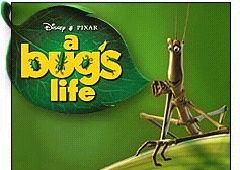

An Interview with
JOHN LASSETER
Part 2
By Lawrence French
LAWRENCE FRENCH: Of course, the design of the bugs had to be caricatures.
JOHN LASSETER: Yes, one of the things we found in doing a lot of research, is that the world of insects is really very colorful, and we really wanted to tap into that.
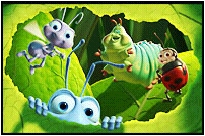 Also, we wanted to make them very appealing. In general, a good deal of the population finds insects kind of icky, or scary, or they have phobias about them, so we wanted to make sure all of our characters were very appealing. So we tended to caricature them. We also didn't want people to think we were trying to reproduce reality, although we like to make a caricatured world that's very believable. We also were very interested in making a colorful movie too, so for all those reasons we caricature the shape and color of the insects.
Also, we wanted to make them very appealing. In general, a good deal of the population finds insects kind of icky, or scary, or they have phobias about them, so we wanted to make sure all of our characters were very appealing. So we tended to caricature them. We also didn't want people to think we were trying to reproduce reality, although we like to make a caricatured world that's very believable. We also were very interested in making a colorful movie too, so for all those reasons we caricature the shape and color of the insects.
LAWRENCE FRENCH: And you gave them big eyes, so they're very expressive.
JOHN LASSETER: Well, lots of bugs have big eyes. It's a positive characteristic of bugs that we were just able to tap into. I've always believed that with an animated character, the audience first looks at the eyes. We put a lot of effort into the eyes of our characters. There's a real nice light that reflects from the bottom of them that gave the irises a nice, rich natural feel.
LAWRENCE FRENCH: Ants can also carry objects much larger than themselves.
JOHN LASSETER: Yes, and we have them carrying large things above their heads. We looked at this one documentary that was very inspiring to us. It was about these leave cutter ants in the Amazon. They basically go en mass to plants and literally use they're mandibles to cut up like scissors pieces of leaves and carry them off to their anthill. They don't live off the pieces of leaves, but the leaves grow mildew, and that's what they actually eat. There's these images of thousands of ants carrying these pieces of leaves down branches and across the ground, and it was just so spectacular to see en mass. I realized when I was watching that, that we could do it. Nobody else in any other medium could do that like we can. We can come up with ways to have a cycle of an ant carrying something, put different things in his hands and multiply that out, in the fact that we have software that knows the terrain. You can create a path on the terrain, and create a cycle and have this long line of ants. That's another thing we're all familiar with. They walk in lines, and if you do something, they all scatter. So we have some imagery like that. In my kitchen, my wife would see some ants and get ready to get out the ant spray, and I'd say, 'wait,' and I'd end up watching them for a long time, seeing how they would move. She'd say, 'would you just get rid of them,' and I'd say, 'no, no, I'm researching'. It was hard to kill them, but when you're kitchen is invested with ants, it's much easier.
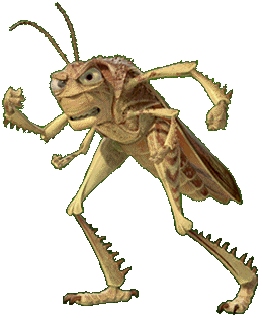 LAWRENCE FRENCH: How far did you want to go in making the grasshoppers frightening?
LAWRENCE FRENCH: How far did you want to go in making the grasshoppers frightening?
JOHN LASSETER: The grasshoppers are the one group of insects where we wanted to keep some of the ickyness of insects in. We wanted to make sure that they were very scary. We really tapped into a lot of things they do that are a little creepy. They have phenomenal detail to them, and are more scary and less appealing. In the end, however, even the grasshoppers are very appealing. Hopper is the bad guy, played by Kevin Spacey, and Molt is his brother, who's always shedding his skin. He's very funny, and he's played by Richard Kind.
LAWRENCE FRENCH: Seeing the trailer for ANTZ and footage from A BUG'S LIFE, I was struck by the contrast. Your film seems far more colorful. ANTZ seems very earth-toned, almost monochromatic.
JOHN LASSETER: To tell a good story, you want to have believable characters, but it is a fantasy world, and we are doing animation, so one of our intentions was to make this beautiful imagery all the way through the movie. We really worked to make this an extremely colorful world. With ant colonies they have anthills and tunnels and we didn't want to go underground and just have dirt, and these black and brown ants. It would be very dreary, so instead we chose to make the ants more colorful.

 The royal family is purple and the other ants are beige to blue. Then we got inspired by these shader programs that make them slightly iridescent. Also, all the lighting underground is done with phosphorescent mushrooms, so you have these very rich blues, greens and yellows when we're underground. Bill Cone who worked on TOY STORY is our production designer, and Bob Pauley and Tia Kratter are art directors. Bob designed all the characters, Bill did the color styling, working closely with Sharon Calahan, our director of photography, who's just an artist when it comes to lighting. And Tia really helped revolutionize the shaders and painting of the texture maps. It was an amazing team, they had so much to do.
The royal family is purple and the other ants are beige to blue. Then we got inspired by these shader programs that make them slightly iridescent. Also, all the lighting underground is done with phosphorescent mushrooms, so you have these very rich blues, greens and yellows when we're underground. Bill Cone who worked on TOY STORY is our production designer, and Bob Pauley and Tia Kratter are art directors. Bob designed all the characters, Bill did the color styling, working closely with Sharon Calahan, our director of photography, who's just an artist when it comes to lighting. And Tia really helped revolutionize the shaders and painting of the texture maps. It was an amazing team, they had so much to do.
LAWRENCE FRENCH: When you started work on BUGS, you were keeping everything top secret. Was the reason for that what's happened with ANTZ-them coming out in October, and beating you to the theaters?
JOHN LASSETER: Yes, that's always the case. It takes so long to make one of these films that until you're really established, you always have to be careful. If you tip your hand too soon, someone can come out and do a shlock version of what you're doing and scoop you, which is what's happening now (with ANTZ). It's sad, because they clearly stole the idea from 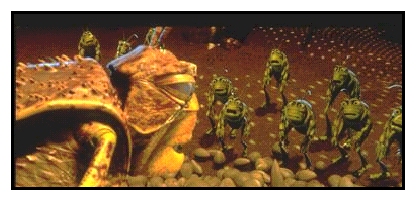 us. But we haven't worried about that too much. We've put it behind us, because we're always going to have competition, regardless of when our movie comes out. So we just want to make the best movie possible and I always say the best movie will win out. And if you do a really good job, and concentrate on telling a great story, with great characters, they become everlasting. TOY STORY is still being watched on videocassette, over and over. I joke with parents, 'I didn't make TOY STORY enjoyable for the first or second time, I made it to be enjoyable when the parents have to suffer through it for the hundredth time on video, which is the case sometimes. We spend four years working on these films, and it takes a tremendous amount of effort and creative energy to make these films, and one of the top priorities I have is I want all the people working on it, who really make these films, to make sure they feel it's worth it in the long run. So years from now, they will proudly tell someone, 'I worked on TOY STORY,' and that will mean something. That's why it's nice to work with Disney, because they place a tremendous value on getting the story to work. So we re-do it in storyboards and story reels, until it works. We have that luxury, where most studios wouldn't devote that kind of time to it.
us. But we haven't worried about that too much. We've put it behind us, because we're always going to have competition, regardless of when our movie comes out. So we just want to make the best movie possible and I always say the best movie will win out. And if you do a really good job, and concentrate on telling a great story, with great characters, they become everlasting. TOY STORY is still being watched on videocassette, over and over. I joke with parents, 'I didn't make TOY STORY enjoyable for the first or second time, I made it to be enjoyable when the parents have to suffer through it for the hundredth time on video, which is the case sometimes. We spend four years working on these films, and it takes a tremendous amount of effort and creative energy to make these films, and one of the top priorities I have is I want all the people working on it, who really make these films, to make sure they feel it's worth it in the long run. So years from now, they will proudly tell someone, 'I worked on TOY STORY,' and that will mean something. That's why it's nice to work with Disney, because they place a tremendous value on getting the story to work. So we re-do it in storyboards and story reels, until it works. We have that luxury, where most studios wouldn't devote that kind of time to it.
LAWRENCE FRENCH: When did you begin recording the actor's voices?
 JOHN LASSETER: We started about 21/2 years ago. We've been working on A BUG'S LIFE for four years. We started in August of '94, a year before TOY STORY came out. What we really try to do is cast great actors, not just for the quality of they're voice, but their acting ability. One thing we found on this film especially, is you develop the character, you figure out what kind of voice you want, what the personality is going to be, and really picture what the character is going to be, then bring in the actor for a recording session, and the actor always records it a little bit different than what you expect. You go back, listen to it and put it in, and the next thing you know you're evolving your character personality wise-what they would say, even the design-to fit better with what the voice actor is giving you. It's very exciting. In casting, we sometimes created the character with an actor's voice in mind and then got that actor to do it. Jonathan Harris is one person like that. We kept thinking about him, knowing him as Dr. Smith from LOST IN SPACE, but not sure if he was still acting anymore. Then we saw him on a special about Irwin Allen, and realized he's still vibrant. We brought him in and he was just amazing. He brought so much to the character of Manny. There are other times where we had lists of actors, from Ruth Lambert the casting director at Disney. We'd find all these amazing actors from Broadway, films or television, that we'd have never even thought of. Julie Louis-Dreyfus came in to read for Rosie, the spider originally, and as soon as we heard her, we said, 'that's Princess Atta.' Phyllis Diller came in to read for the Queen, and she was so funny and perfect, we redesigned the Queen hairdo, to give her this crown, with flowers-it was just this big wild hairdo. Richard Kind, who plays Molt, Hopper's brother, came in to read for a different part, and he made the part he was reading so appealing and great, we thought, 'what about bringing him in as a grasshopper sidekick character.' So we elevated him to Hopper's brother, Molt. We call him the Billy Carter of the insect world. It was also a function of the story, because Hopper is really smart and very tough. Why would he stand for this idiot sidekick to be around all the time? So we came up with the idea of making him his brother. Then, we put in a line, 'I promised mother on her deathbed I wouldn't kill you. If I didn't, I would kill you!' In the end, what Richard Kind brought to part, made Molt so appealing we couldn't kill him off. So he comes back in the epilogue, and P.T. has hired him as a heavy lifting stage hand.
JOHN LASSETER: We started about 21/2 years ago. We've been working on A BUG'S LIFE for four years. We started in August of '94, a year before TOY STORY came out. What we really try to do is cast great actors, not just for the quality of they're voice, but their acting ability. One thing we found on this film especially, is you develop the character, you figure out what kind of voice you want, what the personality is going to be, and really picture what the character is going to be, then bring in the actor for a recording session, and the actor always records it a little bit different than what you expect. You go back, listen to it and put it in, and the next thing you know you're evolving your character personality wise-what they would say, even the design-to fit better with what the voice actor is giving you. It's very exciting. In casting, we sometimes created the character with an actor's voice in mind and then got that actor to do it. Jonathan Harris is one person like that. We kept thinking about him, knowing him as Dr. Smith from LOST IN SPACE, but not sure if he was still acting anymore. Then we saw him on a special about Irwin Allen, and realized he's still vibrant. We brought him in and he was just amazing. He brought so much to the character of Manny. There are other times where we had lists of actors, from Ruth Lambert the casting director at Disney. We'd find all these amazing actors from Broadway, films or television, that we'd have never even thought of. Julie Louis-Dreyfus came in to read for Rosie, the spider originally, and as soon as we heard her, we said, 'that's Princess Atta.' Phyllis Diller came in to read for the Queen, and she was so funny and perfect, we redesigned the Queen hairdo, to give her this crown, with flowers-it was just this big wild hairdo. Richard Kind, who plays Molt, Hopper's brother, came in to read for a different part, and he made the part he was reading so appealing and great, we thought, 'what about bringing him in as a grasshopper sidekick character.' So we elevated him to Hopper's brother, Molt. We call him the Billy Carter of the insect world. It was also a function of the story, because Hopper is really smart and very tough. Why would he stand for this idiot sidekick to be around all the time? So we came up with the idea of making him his brother. Then, we put in a line, 'I promised mother on her deathbed I wouldn't kill you. If I didn't, I would kill you!' In the end, what Richard Kind brought to part, made Molt so appealing we couldn't kill him off. So he comes back in the epilogue, and P.T. has hired him as a heavy lifting stage hand.
LAWRENCE FRENCH: You don't have the really big star names in the vocal cast, like you got for TOY STORY.
 JOHN LASSETER: With TOY STORY we had a casting coup-getting both Tom Hanks and Tim Allen, and we hired them not early in their careers, but just before their meteoric rise. Tom Hanks won two academy awards during the making of TOY STORY. So everybody tried to approach the casting of A BUG'S LIFE with that same notion. Getting someone real big for the main character of Flik, and then in walked Dave Foley, from KIDS IN THE HALL and NEWS RADIO. He's not a big star, like Tom Hanks, but he's a remarkable actor. He brought so much heart to the role, and a certain quality, exactly what we were hoping for, which we call the unlikely hero. He's not your typical hero. To be honest he's a geek. He changes a little within himself, but changes the world around him phenomenally. We like to have messages or lessons in our movies,
although we hate hitting people over the head with it. But in most people's lives they don't inherently make gigantic growths. They are who they are. You change, but what you can really do, is tremendously influence the world around you. I think that's a great lesson, how much you can give to other people. I think that's what Flik does. He really changes the world, because of who he is. In the beginning he's looked down upon, but in the end he's recognized, and he really does change everybody. It's a very special thing. I think it's a lesson, that no matter how geeky or stupid you might be, you really do influence a lot of people.
JOHN LASSETER: With TOY STORY we had a casting coup-getting both Tom Hanks and Tim Allen, and we hired them not early in their careers, but just before their meteoric rise. Tom Hanks won two academy awards during the making of TOY STORY. So everybody tried to approach the casting of A BUG'S LIFE with that same notion. Getting someone real big for the main character of Flik, and then in walked Dave Foley, from KIDS IN THE HALL and NEWS RADIO. He's not a big star, like Tom Hanks, but he's a remarkable actor. He brought so much heart to the role, and a certain quality, exactly what we were hoping for, which we call the unlikely hero. He's not your typical hero. To be honest he's a geek. He changes a little within himself, but changes the world around him phenomenally. We like to have messages or lessons in our movies,
although we hate hitting people over the head with it. But in most people's lives they don't inherently make gigantic growths. They are who they are. You change, but what you can really do, is tremendously influence the world around you. I think that's a great lesson, how much you can give to other people. I think that's what Flik does. He really changes the world, because of who he is. In the beginning he's looked down upon, but in the end he's recognized, and he really does change everybody. It's a very special thing. I think it's a lesson, that no matter how geeky or stupid you might be, you really do influence a lot of people.
LAWRENCE FRENCH: Of course, you as a filmmaker have this tremendous power to shape and influence people, particularly younger viewers, who might be seeing their first film.
JOHN LASSETER: I take tremendous responsibility in that. I'm fully aware of how we do affect people. I believe filmmakers should take that responsibility very seriously, and I think there's an awful lot of irresponsibility in films, especially in films intended for kids. I'm a father of five, and every movie I make, I want to be able to take my teenager,
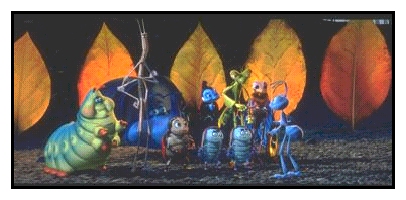 where he'll find it cool to go and see it with his friends. I also want to feel good about taking my three year old to it. It might scare him a little bit, but every good Disney film did, a little bit. But there's humor, there's heart, you laugh, you cry. But I believe you can also make a family film that is not just for kids. We make movies for ourselves. We make movies basically for ourselves. We're intelligent, artistic, and fun. There's very hip people here at Pixar. I'm not, but other people are. We have families, and take great pride in making a film that everyone who works very hard on it, will be proud to take their parents, or friends and kids to see it. That's important to me because everybody really kills themselves working on these movies. In the past I've worked really hard on commercials or other films, and in the end you go, 'I killed myself for that?' It makes you a little less willing to do it the next time. The foundation of what I believe, as VP of creative at Pixar, is if you can make a studio, where years from now people will be proud to say, 'I worked on TOY STORY,' or 'I worked on A BUG'S LIFE.' Also, I want the audience not to feel cheated. When they go to see the movie, they are giving you 90 minutes of their lives, and I want them to think, 'that was worth it.' I take responsibility for that. I want them to feel it wasn't a waste of their time. You want the audience to be satisfied.
where he'll find it cool to go and see it with his friends. I also want to feel good about taking my three year old to it. It might scare him a little bit, but every good Disney film did, a little bit. But there's humor, there's heart, you laugh, you cry. But I believe you can also make a family film that is not just for kids. We make movies for ourselves. We make movies basically for ourselves. We're intelligent, artistic, and fun. There's very hip people here at Pixar. I'm not, but other people are. We have families, and take great pride in making a film that everyone who works very hard on it, will be proud to take their parents, or friends and kids to see it. That's important to me because everybody really kills themselves working on these movies. In the past I've worked really hard on commercials or other films, and in the end you go, 'I killed myself for that?' It makes you a little less willing to do it the next time. The foundation of what I believe, as VP of creative at Pixar, is if you can make a studio, where years from now people will be proud to say, 'I worked on TOY STORY,' or 'I worked on A BUG'S LIFE.' Also, I want the audience not to feel cheated. When they go to see the movie, they are giving you 90 minutes of their lives, and I want them to think, 'that was worth it.' I take responsibility for that. I want them to feel it wasn't a waste of their time. You want the audience to be satisfied.
LAWRENCE FRENCH: Steve Jobs says Pixar's goal is to make an animated film a year. Will that compromise the quality of the pictures?
JOHN LASSETER: Well, the goal is to hire the best people in the industry, and enough of them, so we can have overlapping productions. So while one picture is in development, another is in production. It's not about turning them out faster, it's about having them overlap, so when people come off of one picture, they're ready to go on to another. But we're still stressing story. It's story, story, story. I always find it amazing that movies start shooting with the script unfinished. How can you know what the beginning of the movie should be, until you know what the end is? What we try to do, is tie everything together nicely, so everything is set up with something that will pay off later, but it doesn't feel like a set-up. We really make movies for ourselves. We like really good movies, with great characters in a really well told story, so there's not a wasted thing. Every little story point is setting you up for the payoff.
LAWRENCE FRENCH: You're also continuing to make short films, like GERI'S GAME.
JOHN LASSETER: Yes, we have a program that we've started,
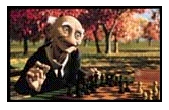 where we plan to fund two short films a year, made by different people within the company. Everybody at Pixar has the opportunity to submit ideas and we have a small review board that looks at the ideas. We have a bunch of great ideas. GERI'S CAME was directed by Jan Pinkava, who is one of the directors whose done commercials for us for a number of years. One of the things I want to do, is to try to give to the people working at Pixar the opportunity that I had in making short films. In the eighties, the shorts were helping us focus on research, but it also gave me a personal opportunity to develop my storytelling and directorial ability. It really showed the world what I could do. I love the short film form, but unfortunately, it
where we plan to fund two short films a year, made by different people within the company. Everybody at Pixar has the opportunity to submit ideas and we have a small review board that looks at the ideas. We have a bunch of great ideas. GERI'S CAME was directed by Jan Pinkava, who is one of the directors whose done commercials for us for a number of years. One of the things I want to do, is to try to give to the people working at Pixar the opportunity that I had in making short films. In the eighties, the shorts were helping us focus on research, but it also gave me a personal opportunity to develop my storytelling and directorial ability. It really showed the world what I could do. I love the short film form, but unfortunately, it
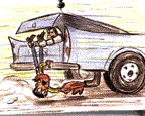 doesn't have much of a commercial market. That's why you don't see many short films, but there are still the animation festivals, so they can be shown on the animation circuit. It's very important to me to show the animation world that Pixar is made up of a lot of really talented visionaries-story artists, directors, animators. It's not just a place where I make films. We're working on our next two features right now. TOY STORY 2 will be out next year, and Ash Brannon and Colin Brady are directing it. I will be the executive producer, and Ralph Guggenheim is producing. We've gotten the whole vocal cast to return, including Tom Hanks and Tim Allen. Pete Docter is developing ideas for our fourth movie, HIDDEN VALLEY, so we're really starting to develop these guys. I'll continue making features until they drag me away, but I also want to give some other talented people at Pixar a chance. It's like the John Lasseter school of directing. I'm helping a number of people here to hone their directing skills.
doesn't have much of a commercial market. That's why you don't see many short films, but there are still the animation festivals, so they can be shown on the animation circuit. It's very important to me to show the animation world that Pixar is made up of a lot of really talented visionaries-story artists, directors, animators. It's not just a place where I make films. We're working on our next two features right now. TOY STORY 2 will be out next year, and Ash Brannon and Colin Brady are directing it. I will be the executive producer, and Ralph Guggenheim is producing. We've gotten the whole vocal cast to return, including Tom Hanks and Tim Allen. Pete Docter is developing ideas for our fourth movie, HIDDEN VALLEY, so we're really starting to develop these guys. I'll continue making features until they drag me away, but I also want to give some other talented people at Pixar a chance. It's like the John Lasseter school of directing. I'm helping a number of people here to hone their directing skills.
 LAWRENCE FRENCH: Would you do a short Buzz Lightyear cartoon, like Disney did with Roger Rabbit? Maybe even using the Buzz Lightyear cartoon you developed, but didn't use in TOY STORY.
LAWRENCE FRENCH: Would you do a short Buzz Lightyear cartoon, like Disney did with Roger Rabbit? Maybe even using the Buzz Lightyear cartoon you developed, but didn't use in TOY STORY.
JOHN LASSETER: No, we wouldn't' do that as a short. The ideas for short films that have been pitched are widely varied and original ideas, thought up by the different people at Pixar. We did do these short TOY STORY TREATS, for ABC Saturday morning television. We took all the characters from TOY STORY and animated well over fifty 10-second and 30-second gags, and it came out to a running time of 15 minutes. It was really very exciting to see, because there were really funny bits of business, some of which we originally thought of for TOY STORY, which we made into funny little gags. It was so much fun to do, because we know the characters so well. Frankly, one of the most difficult things to do is to develop a character and it's personality, and how it will fit into the story. I often say, they aren't creations, but they're employee's of Pixar, because the characters are so alive in our minds. So once you have the character, it's fun to do stuff with them like the TOY STORY TREATS. We'd say, "we need a gag with Rex and the little Martians," and then we'd come up with a bunch of different gags. It was fun.
 LAWRENCE FRENCH: Andrew Stanton was saying a story problem occurred in justifying why the circus bugs would stay and fight the grasshoppers, when it means putting their lives on the line. How does Flik convince them to stay and help?
LAWRENCE FRENCH: Andrew Stanton was saying a story problem occurred in justifying why the circus bugs would stay and fight the grasshoppers, when it means putting their lives on the line. How does Flik convince them to stay and help?
JOHN LASSETER: He convinces them by asking them to help build this bird scarecrow. He tells them to just help build it, and they'll be long gone before the grasshoppers show up. That gives them their out, since there is no possibility they'll get caught in the fighting. But also, they have nowhere else to go down, the emotional reason they stay, is that for the first time they are appreciated. To the ants they're hero's and the kids are asking them for autographs. In the circus, they're booed, and they can't even draw flies. That's the subtext, because everyone
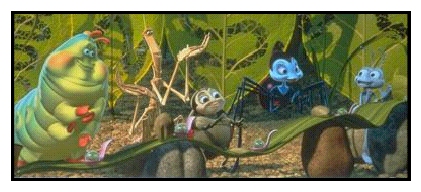 wants to be appreciated. But they start fronting to be something that they're not. Flik tells the colony that they're warrior bugs, and they front for him, loving the adulation of being who they're not. Everyone feels good about the association, but it's all built on falsehoods and lies. Then, when they find out the truth, everything comes crumbling down. It's a very emotional moment when the ants find out. They've been fired from the circus, and deep who these warrior bugs really are, and that Flik has been lying all this time. Their confidence is shattered. It's a very touching moment, because Princess Atta is starting to like Flik, and she's just crushed that Flik has been lying to her, so he's banished from the island. At that point, it's very dark and gloomy, and it's not until Flik comes to terms with not thinking of himself that the sun comes out again, because basically he's been making decisions based about how people will think about him. When he realizes he's hired the wrong people, he thinks,
wants to be appreciated. But they start fronting to be something that they're not. Flik tells the colony that they're warrior bugs, and they front for him, loving the adulation of being who they're not. Everyone feels good about the association, but it's all built on falsehoods and lies. Then, when they find out the truth, everything comes crumbling down. It's a very emotional moment when the ants find out. They've been fired from the circus, and deep who these warrior bugs really are, and that Flik has been lying all this time. Their confidence is shattered. It's a very touching moment, because Princess Atta is starting to like Flik, and she's just crushed that Flik has been lying to her, so he's banished from the island. At that point, it's very dark and gloomy, and it's not until Flik comes to terms with not thinking of himself that the sun comes out again, because basically he's been making decisions based about how people will think about him. When he realizes he's hired the wrong people, he thinks,
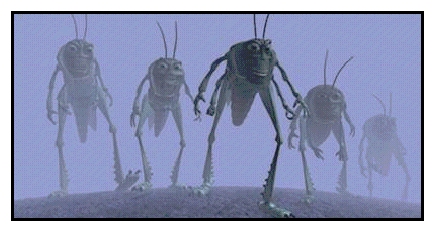 'I'll be branded a loser the rest of my life, I can't do this.' So he's doing the right thing, but for the wrong reasons. When he finally does something as a selfless act, then the sun comes out again. It's a really neat scene, where they're in the shadows, and Princess Dot comes and convinces him to come back to the colony in a very clever way. Even after Flik has been banished, and they're trying to find enough food to give the grasshoppers, it's a very foggy, gray day. We sucked all the color out of it, which gives it a dark quality, and then when everything works out, we have an epilogue where it's springtime, and we have the most vibrant color of the movie. So like in TOY STORY we really try to use color to help the underlying emotions. I believe that in any scene the words being spoken can say one thing, and the underlying emotion can be told through lighting and color and music to say another thing.
'I'll be branded a loser the rest of my life, I can't do this.' So he's doing the right thing, but for the wrong reasons. When he finally does something as a selfless act, then the sun comes out again. It's a really neat scene, where they're in the shadows, and Princess Dot comes and convinces him to come back to the colony in a very clever way. Even after Flik has been banished, and they're trying to find enough food to give the grasshoppers, it's a very foggy, gray day. We sucked all the color out of it, which gives it a dark quality, and then when everything works out, we have an epilogue where it's springtime, and we have the most vibrant color of the movie. So like in TOY STORY we really try to use color to help the underlying emotions. I believe that in any scene the words being spoken can say one thing, and the underlying emotion can be told through lighting and color and music to say another thing.
Part 3 of the John Lasseter Interview
now available